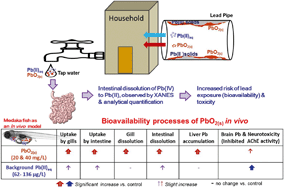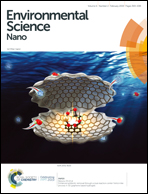In vivo evidence of intestinal lead dissolution from lead dioxide (PbO2) nanoparticles and resulting bioaccumulation and toxicity in medaka fish†
Abstract
Nanoscale lead (Pb) dioxide particles (nPbO2) are a newly identified corrosion product formed inside lead-bearing pipes or lead-containing faucets in drinking water distribution systems. These particles can release toxic lead ions, which cause drinking-water contamination and lead poisoning in humans, especially children. nPbO2 may be dislodged from pipes into drinking water; however, little research has focused on the bioavailability and toxicity of nPbO2in vivo. In this study, we used adult medaka fish (Oryzias latipes) as an animal model to investigate the uptake, lead dissolution, bioaccumulation and toxic effects of nanoscale [nPbO2] and microscale bulk [bPbO2] Pb dioxide and Pb(II)aq (Pb2+) in vivo upon acute to sub-chronic aqueous exposure. Both types of PbO2 particles were chemically stable in dechlorinated tap water with low water solubility. However, the X-ray absorption near-edge structure (XANES) analysis and analytical quantification of lead speciation showed that both nPbO2 and bPbO2 could be reductively dissolved into Pb(II)aq in both the intestine (major uptake route) and gills of the fish; thereby, enhancing hepatic Pb accumulation. The fish brains exhibited greater Pb accumulation and acetylcholinesterase inhibition with Pb(II)aq treatment than all the PbO2 treatments. The Pb content was greater in the gills, liver and brain with nPbO2 than bPbO2. This in vivo evidence implies the possibility of increased risk of exposure to Pb dissolution from PbO2 particles in the digestive system via drinking water, which can enhance the bioavailability of Pb uptake and toxicity in humans.



 Please wait while we load your content...
Please wait while we load your content...